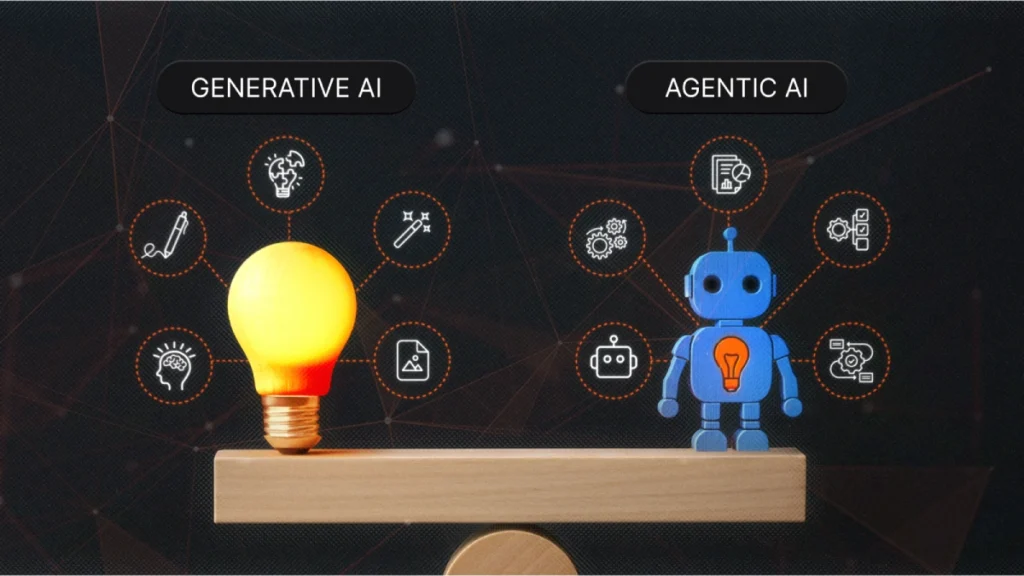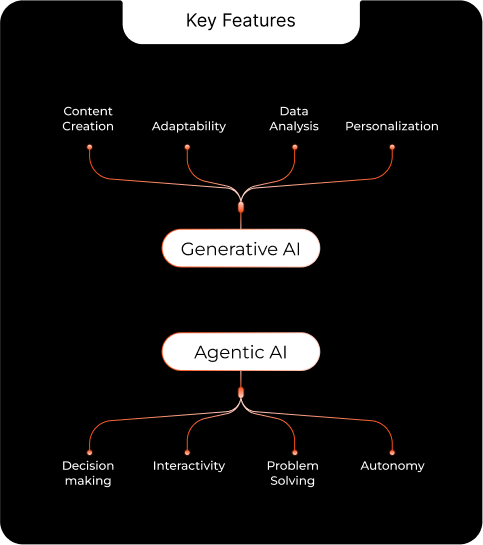
From board meetings to LinkedIn feeds, two words are being used almost interchangeably - Generative AI and Agentic AI. While they may sound similar, they represent distinct stages in AI’s evolution, and confusing the two can lead to misguided investments, unrealistic expectations, and fragmented transformation strategies.
According to Gartner's Hype Cycle, AI leaders are facing challenges in proving Gen AI’s value to the business. Even after an average spend of $1.9 million on Gen AI initiatives in 2024, not even 30% of leaders report that their CEOs are happy with the AI investment return.
At the same time, Gartner predicts more than 40% of agentic AI projects will be canceled by the end of 2027 due to escalating costs and unclear business value.
This proves enterprises are still struggling to drive impact and turn experimentation into execution.
As a leader, it's important to understand these technologies to drive business impact. To cut short, Generative AI creates, and Agentic AI acts.
Difference between Agentic AI and Generative AI
Generative AI: The Creative Engine
When you prompt ChatGPT to summarize a report or write code, or when a model like DALL-E generates product mock-ups, that’s generative AI in action. It is designed to produce content like texts, images, code, or data, based on learned patterns from massive datasets.
From a system design perspective, these models:
- Take input (prompt + context)
- Generate output (text, image, code, etc.)
- Rely on pattern recognition and probability
- Operate within a single-turn or short-loop interaction
This makes Gen AI ideal for content generation, ideation, code assistance, and knowledge discovery, but when it comes to autonomous action or long-horizon decision-making, its capabilities fall short. For example, it can write an optimized logistics report, but it won’t decide to re-route shipments when a delay occurs.

Agentic AI: The Autonomous Operator
Agentic AI, on the other hand, can plan, reason, call APIs or enterprise tools, and iteratively refine its actions to achieve an outcome. It’s the next step, where an intelligent system can generate insight and take goal-directed action.
Agentic systems are built on generative AI with additional layers:
- Break a complex goal into sub-tasks
- Use tools to invoke APIs, run queries, or interact with external systems
- Recall memory, past interactions, and learning from results
- Self-evaluate output before execution
- Autonomously decide when to act, ask for clarification, or stop
This makes agentic AI an autonomous agent that does it all. For example, a supply chain agentic system can autonomously detect a supplier delay, re-run demand forecasts, identify alternate vendors, and update ERP records, all while keeping a human in the loop for approval.
At a Glance: Gen AI vs Agentic AI
| Aspect | Generative AI | Agentic AI |
|---|---|---|
| Primary Function | Creates content, summarizes, and ideates | Plans, executes, and iteratively acts |
| Autonomy | Low; human decision needed | High; can act independently within governance |
| Workflow Scope | Single-turn or short-loop | Multi-step, goal-oriented tasks |
| System Capabilities | Pattern recognition, content generation | Planning, memory, API/tool use, critical loops |
| Enterprise Example | Drafts reports, generates product mock-ups | Automatically re-routes shipments, updates ERP, triggers alerts |
Agentic AI and Generative AI Use Cases in Supply Chains
Generative AI Use Cases
- Demand Forecasting & Planning: In pharma and life sciences, AI models can summarize historical sales data, seasonal patterns to forecast accurate demand. Meanwhile, retail and CPG companies use generative models to simulate product promotions, price optimization, or SKU-level demand.
- Knowledge & Document Summarization: Manufacturing supply chain often deals with large volumes of maintenance logs, SOPs, supplier documentations, and quality reports. Generative AI can extract key insights and point out potential risks, enabling planners to act more efficiently.
- Scenario Simulation & Reporting: Generative AI can create logistics reports, suggest alternative routes for shipping, achieve sustainability goals, or simulate supply chain disruptions, giving decision-makers faster visibility into potential outcomes.
Limitations of Gen AI
Generative AI accelerates ideation, improves visibility, and reduces the time teams spend analyzing data, but it does not take autonomous action. That’s where agentic AI comes in.
Agentic AI Use Cases
Agentic AI goes a step further, helping organizations act faster by autonomously executing tasks, optimizing workflows, and closing the loop between insight and action.
- Automated Inventory & Logistics Management: In retail and CPG supply chains, agentic AI can dynamically reallocate inventory between warehouses or stores based on real-time demand, automatically trigger re-orders for fast-moving SKUs, and update ERP/fulfillment systems.
- Autonomous Production & Scheduling: Industrial manufacturing companies use agentic AI to adjust production sequences on the fly, optimize machine usage, and coordinate predictive maintenance without manual intervention.
- Supply Chain Risk Management: Pharma companies deploy agentic systems to detect raw material delays, automatically identify alternative suppliers, re-run forecasts, and update distribution schedules — all while maintaining human-in-the-loop oversight for critical decisions.
- Compliance & Documentation Automation: Across industries, agentic AI ensures that all executed actions adhere to regulatory and operational guidelines, generating audit logs and notifications automatically.
Limitation
Agentic AI transforms supply chains from reactive to proactive. Executing insights autonomously reduces latency, minimizes errors, and improves resilience across complex operations. However, without the right workflow and poor data, it can go rogue and make the wrong decisions.
Does your business need Generative AI or Agentic AI?
Generative AI and Agentic AI serve different functions in the enterprise stack. Enterprises don’t necessarily need to choose one over the other; the decision lies in where and how each can deliver value.
Gen AI can augment human creativity, support decision-making, and generate content. It’s ideal when the goal is to produce, summarize, or rethink information. For instance, in customer-facing operations, generative AI powers conversational assistants that can draft emails, summarize calls, or create SKU descriptions, all with speed and scale.
Agentic AI excels when enterprises move from insight generation to autonomous execution. It can make decisions, trigger actions, and monitor outcomes. For example, a procurement agent can autonomously negotiate with suppliers, cross-check invoices, and raise purchase orders.
Driving Impact from Intelligence
At Syren, clients come to us at different stages of their AI journey — some starting from scratch, others experimenting mid-way, and some already deep in investments but struggling to see results. That’s why our AI consultation goes beyond implementation. We design tailored, outcome-driven solutions that align with business priorities, whether it’s deploying GenAI for speed and scale or building Agentic AI systems that think, act, and improve autonomously.
To run a smarter business, let Syren lead the way.


